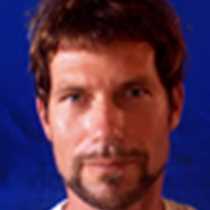North Seymour and Rábida Island
Our first morning in the archipelago starts with calm weather and a smooth ocean. Some of us are up early to take in a cryptic landscape. You don’t expect very straight cliffs on both sides of your viewing spectrum when you think of tropical islands. It is because we are anchored in a natural channel, called a graben, formed by volcanic pressure lifting up big parts of the seabed.
On the horizon in the west we see two old tuff cones called Daphne Major and Daphne Minor. The first is famous to many ornithologists, for it is there that Peter and Rosemary Grant have done their research on finch populations. Their research started in the 1970s and still continues. It is called one of the best showcases of evolution in the flesh. Their research is still groundbreaking in our understanding of how variations in environment can make a species adapt, perish or prosper. Thanks to their and their students’ meticulous routine of taking data, they have proven that evolution is an existing and ever-ongoing process. We could say they finished what Charles Darwin started.
After breakfast we land on North Seymour, where we mainly see frigatebirds, blue-footed boobies, land iguanas and sea lions. Many of us are surprised by how fearless and close the animals are. We see them as we like best: minding their daily tasks, at ease it first seems, although we are slowly becoming aware of the dangers and hardships an endemic Galápagos resident endures.
The morning is mild, with a cloudy sky and a light breeze, but the vegetation is proof of a harsh and dry environment, where any neglect can be fatal. Fresh water is almost nowhere to be found. There is no shade. The only edible material on the island, besides other animals, is found in the form of tiny hard seeds and small, spiny cactus fruits. And these very few resources have to be shared with a fierce competition.
No, this is not a picnic in the park. It is only after understanding this reality that our respect for these strange and wonderful creatures can reach its true dimension.
In the afternoon we explore the underwater world, which is wonderfully vivid with color, sound and life. We see small fry, many different reef fish, sea turtles, sea lions and even marine iguanas eating underwater. The visibility, helped by the bright daylight, is excellent and the water has an invigorating effect on us. We play with sea lion puppies which seem to have been waiting for us and we are amazed by their agility and playfulness. It is this behavior that makes you want to stay with them for hours and we have a hard time leaving them, to take a last walk this afternoon on Rabida, where we are witness to a beautiful sunset.
Back on board we are all full of stories, the images still vivid in our minds. What a fantastic day, and just the first of many to come!




